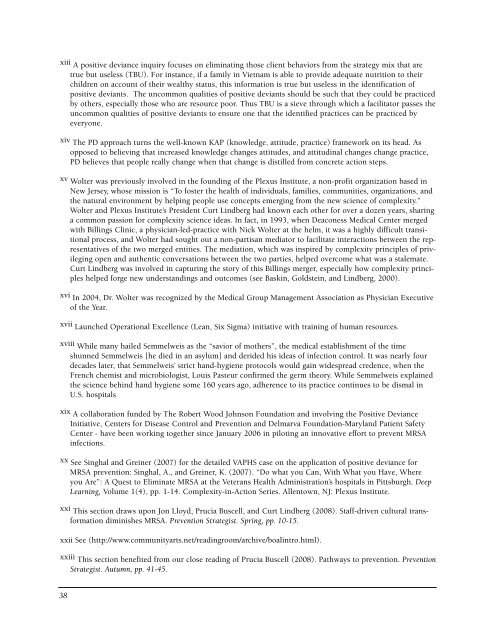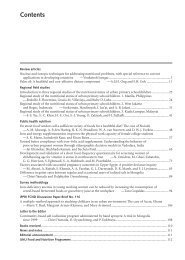From Invisible to Visible - Positive Deviance Initiative
From Invisible to Visible - Positive Deviance Initiative
From Invisible to Visible - Positive Deviance Initiative
Create successful ePaper yourself
Turn your PDF publications into a flip-book with our unique Google optimized e-Paper software.
xiii A positive deviance inquiry focuses on eliminating those client behaviors from the strategy mix that are<br />
true but useless (TBU). For instance, if a family in Vietnam is able <strong>to</strong> provide adequate nutrition <strong>to</strong> their<br />
children on account of their wealthy status, this information is true but useless in the identification of<br />
positive deviants. The uncommon qualities of positive deviants should be such that they could be practiced<br />
by others, especially those who are resource poor. Thus TBU is a sieve through which a facilita<strong>to</strong>r passes the<br />
uncommon qualities of positive deviants <strong>to</strong> ensure one that the identified practices can be practiced by<br />
everyone.<br />
xiv The PD approach turns the well-known KAP (knowledge, attitude, practice) framework on its head. As<br />
opposed <strong>to</strong> believing that increased knowledge changes attitudes, and attitudinal changes change practice,<br />
PD believes that people really change when that change is distilled from concrete action steps.<br />
xv Wolter was previously involved in the founding of the Plexus Institute, a non-profit organization based in<br />
New Jersey, whose mission is “To foster the health of individuals, families, communities, organizations, and<br />
the natural environment by helping people use concepts emerging from the new science of complexity.”<br />
Wolter and Plexus Institute’s President Curt Lindberg had known each other for over a dozen years, sharing<br />
a common passion for complexity science ideas. In fact, in 1993, when Deaconess Medical Center merged<br />
with Billings Clinic, a physician-led-practice with Nick Wolter at the helm, it was a highly difficult transitional<br />
process, and Wolter had sought out a non-partisan media<strong>to</strong>r <strong>to</strong> facilitate interactions between the representatives<br />
of the two merged entities. The mediation, which was inspired by complexity principles of privileging<br />
open and authentic conversations between the two parties, helped overcome what was a stalemate.<br />
Curt Lindberg was involved in capturing the s<strong>to</strong>ry of this Billings merger, especially how complexity principles<br />
helped forge new understandings and outcomes (see Baskin, Goldstein, and Lindberg, 2000).<br />
xvi In 2004, Dr. Wolter was recognized by the Medical Group Management Association as Physician Executive<br />
of the Year.<br />
xvii Launched Operational Excellence (Lean, Six Sigma) initiative with training of human resources.<br />
xviii While many hailed Semmelweis as the “savior of mothers”, the medical establishment of the time<br />
shunned Semmelweis [he died in an asylum] and derided his ideas of infection control. It was nearly four<br />
decades later, that Semmelweis’ strict hand-hygiene pro<strong>to</strong>cols would gain widespread credence, when the<br />
French chemist and microbiologist, Louis Pasteur confirmed the germ theory. While Semmelweis explained<br />
the science behind hand hygiene some 160 years ago, adherence <strong>to</strong> its practice continues <strong>to</strong> be dismal in<br />
U.S. hospitals<br />
xix A collaboration funded by The Robert Wood Johnson Foundation and involving the <strong>Positive</strong> <strong>Deviance</strong><br />
<strong>Initiative</strong>, Centers for Disease Control and Prevention and Delmarva Foundation-Maryland Patient Safety<br />
Center - have been working <strong>to</strong>gether since January 2006 in piloting an innovative effort <strong>to</strong> prevent MRSA<br />
infections.<br />
xx See Singhal and Greiner (2007) for the detailed VAPHS case on the application of positive deviance for<br />
MRSA prevention: Singhal, A., and Greiner, K. (2007). “Do what you Can, With What you Have, Where<br />
you Are”: A Quest <strong>to</strong> Eliminate MRSA at the Veterans Health Administration’s hospitals in Pittsburgh. Deep<br />
Learning, Volume 1(4), pp. 1-14. Complexity-in-Action Series. Allen<strong>to</strong>wn, NJ: Plexus Institute.<br />
xxi This section draws upon Jon Lloyd, Prucia Buscell, and Curt Lindberg (2008). Staff-driven cultural transformation<br />
diminishes MRSA. Prevention Strategist. Spring, pp. 10-15.<br />
xxii See (http://www.communityarts.net/readingroom/archive/boalintro.html).<br />
xxiii This section benefited from our close reading of Prucia Buscell (2008). Pathways <strong>to</strong> prevention. Prevention<br />
Strategist. Autumn, pp. 41-45.<br />
38

















